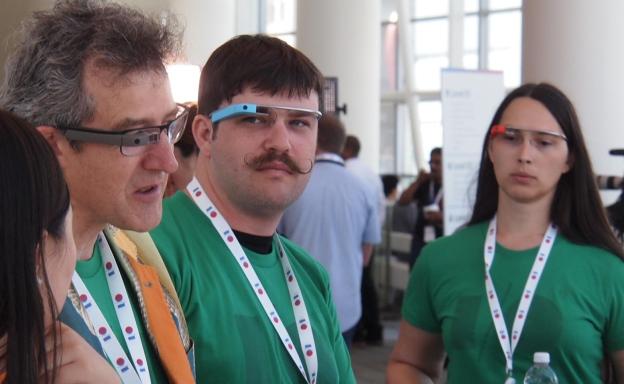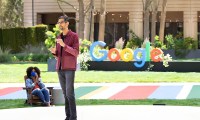
The first one I spotted was a lumbering man with blue hair, an oversized t-shirt, and Crocs. A Glasser. Like a monocle from the future, it’s clear plastic screen covered part of his right eye.
He walked around aimlessly, looking at the ceiling, floor, and Googley decorations in the Moscone Center with rapt attention, as if wearing Glass changed the entire world around him. Occasionally he’d put his hand to the white, robotronic side of his face and swipe it, or press a button. It looked like he was taking pictures of everything.
And then I noticed another Glass wearer. Then another. Then a group of them. Coming to Google I/O this year felt like wandering into a cyborg apocalypse. There are 6,000 attendees, and somewhere between 1,000 and 2,000 of them are infected with Glass. There were always a few of them in sight, and like a thousand little eyes of Sauron, their cameras peered about, potentially snapping pictures of anything and everything.
Google I/O is a sanctuary for Glass owners – a place where this small sub-species of humanity can be treated like anyone else. The outside world, we learned, can be a little strange for the newly Glassed.

Brian Klug (@nerdtalker) from Anandtech bought his Glass in gray, he said, because it’s the least conspicuous color. Though far less obvious than Geordi La Forge’s visor from Star Trek, Glass still stands out in a crowd. Buy it in bright blue, white, or an even bolder color, and it’s impossible to miss.
“On my way back from the station the other day, a couple of old ladies asked me “Hey, is that the Google Glass? How is it? What does it do?” said Harkeerat Toor, an Android developer at Kiefer Consulting. “It’s a nice way to strike up a conversation. But you get stares when you’re on the bus. People will look at you and do a double take,” So should you really wear it everywhere? ”I’m still a little bit skeptical. I think maybe [you can wear it] in places you’re familiar with. Like I wouldn’t mind wearing it at work. That would be cool. I don’t know about just walking down the street.”
“If I have to spy, I could do a better job with my phone than wearing the Glass.”
“I was at the grocery store and the employees were not comfortable with me wearing Glass,” said Lagvankar. “They were kind of uncomfortable and I had to explain it to them. They asked me “Are you recording anything?” and “Why are you wearing that?” The good thing is that after the employees brought it up, a lot of people gathered around and I had a chance to talk with them and explain it.”

The suspicion, Lagvankar felt, was unwarranted.
“If I have to spy, I could do a better job with my phone than wearing the Glass,” he explained. “By putting the Glass there, I’m making it more obvious that there’s a camera right there. There are spying apps on your phone, which actually make your phone look like it’s in sleep mode while it’s capturing video. It’s just a matter of people being aware of these things.”
Despite the sometimes-unwanted attention Glass provokes, most adopters say they’re getting used to it.
Next page: The Good and Bad of Glass
The consensus on Glass
So is Glass worth the inconvenience of being stared at, questioned, and prodded? It depends who you ask. Google employees are evangelists; journalists are skeptical; and developers are drooling over the potential, but not sold on the current product.
You’re pretty much buying a $1,500 clock widget for your eye – and a camera.
But even in a bubble of Googley goodwill, there were problems. Chief among them: Glass just doesn’t do much. Though it could someday revolutionize the world (maybe?), right now you’re pretty much buying a $1,500 clock widget for your eye – and a camera. It can also show you videos, texts, and its battery life, but not a whole lot else.

Because its battery life is atrocious (some owners reported charging their units twice a day), most of the time you’re wearing Glass, it doesn’t do much of anything. It simply sleeps, much like your phone, until you need it. And many owners find the allegedly intuitive interface annoying. To wake it, you jerk your head up or tap the touch panel on the side. As Fred Armisen so aptly demonstrated in a recent Saturday Night Live skit, this doesn’t always work right.
“At first the little head motion to turn the display on and off annoyed the hell out of me,” said Kevin Moore of DiddiaSix. “I would nod my head just a little bit and it would either come on when I don’t want it to or come off. So I ended up turning that off.”
When awoken from its slumber, a little screen appears in the upper right of your field of vision, seemingly about three feet from your face. It looks kind of like a hologram from Star Wars, just not entirely blue. It’s half-transparent and the colors are dull (expect some trouble in the sun), but it’s a working screen.
Glass doesn’t work without being tethered to your smartphone. So once you boot it up, you need to connect it. Or reconnect it, if there are problems, which there often are on these developer units. And that’s just one bug.
“When I get text messages, it sometimes doesn’t show up on my phone, but it will always show up on my Glass,” complained Harkeerat Toor. ”I don’t know if Glass is stealing it, or something. It’s taking a couple of them away. So that’s weird.”
To navigate the menus, which are basically a series of full-screen cards, you can use touch or voice. Since the screen is small, semi-transparent, and only 640 x 360 pixels, you can never really have much information visible at any one time. Twitter is really the perfect app for Glass, because a single 140-character tweet is about all the screen can hold. In a way, Glass is a lot like the Twitter of mobile computers: It can do only a fraction of the things a smartphone can, but those who like the few features it offers seem to really take to it.

Parents, including Google CEO Larry Page, were the most enthusiastic Glass owners at I/O. “I have an 18-month old daughter at home, so I’m really looking forward to being able to video chat and take more photos and stuff,” Matt Schmandt of Lifestyle Communities told us.
Who knew? Jamming a hands-free camera onto a new parent’s face makes it easier for them to take a million more photos of their children. We’re guessing that this will taper off by their second or third kid.
While there are many technical downsides, one of the biggest complaints was the inability to wear Glass with regular glasses. Hardly anyone at the show wore Glass and glasses at the same time, and more than a few people reported having to switch to contacts to wear it. One poor gent had his Glass hanging on his neck because it was too painful to wear them with his regular eyewear. Others could be seen holding Glass in their hands at times or putting it away to wear glasses. Google has promised to address this issue, but no solution is available yet.

Though a lot of groups are making a fuss about the problems with a huge number of people wearing headsets with cameras, by the end of our second day at Google I/O, we got pretty used to it. Somewhere between a fifth and a third of all people at the show were wearing Glass, yet there were no real problems. We didn’t hear of any massive privacy invasions, and no fistfights broke out from antsy Glass owners photographing too much. Mostly, things were completely normal and nerdy, as they should be.
Like with wireless Bluetooth headsets, people looked a little weird at times, as they fiddled with the screens on their face or talked to themselves. Often you’d see people standing still with deadman eyes as they looked up at their Glass. But the world didn’t end. No vortex opened up in the food court of Google I/O. People were still talking and communicating, perhaps more than usual as they talked about their Glass experiences. And though there were thousands of Glass users, we didn’t really encounter any Glassholes. Well, except for Robert Scoble. He was definitely there. (Here’s his infamous Google Glass shower pic.)
We asked a lot of users if they think Glass will ever be a mainstream product, and though they spent $1,500 to buy it, most of them really don’t think it will be the next great innovation. At least, not for a good long while. Kevin Moore, one of the younger attendees, explained Glass best.
“I think it’s going to be more of a geeky product rather than someone wearing one every day. Right now most people I know would rather use their phone for navigation, texting and searching for things than wear a geeky looking, RoboCop-type piece of headgear. But as of now, its mostly people that know what they’re doing and ‘nerds’ that are gonna want to use Glass.”
His big idea: Glass should do things like automatically scan your fridge when you open it and tell you what you can cook with it. Hopefully Google is listening.


